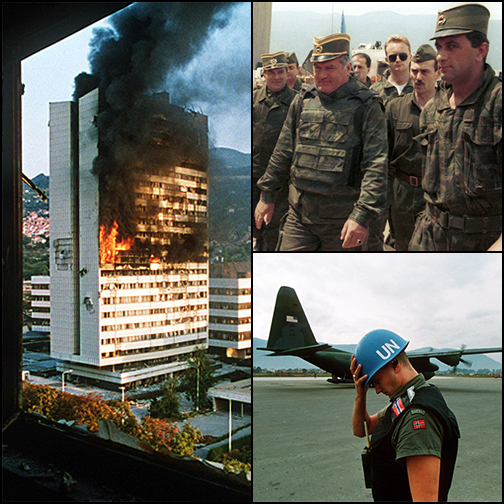Related Research Articles

The term Greater Serbia or Great Serbia describes the Serbian nationalist and irredentist ideology of the creation of a Serb state which would incorporate all regions of traditional significance to Serbs, a South Slavic ethnic group, including regions outside modern-day Serbia that are partly populated by Serbs. The initial movement's main ideology (Pan-Serbism) was to unite all Serbs into one state, claiming, depending on the version, different areas of many surrounding countries.

The Yugoslav Wars were a series of separate but related ethnic conflicts, wars of independence, and insurgencies that took place in the SFR Yugoslavia from 1991 to 2001. The conflicts both led up to and resulted from the breakup of Yugoslavia, which began in mid-1991, into six independent countries matching the six entities known as republics which previously composed Yugoslavia: Slovenia, Croatia, Bosnia and Herzegovina, Montenegro, Serbia, and North Macedonia. Yugoslavia's constituent republics declared independence due to unresolved tensions between ethnic minorities in the new countries, which fuelled the wars. While most of the conflicts ended through peace accords that involved full international recognition of new states, they resulted in a massive number of deaths as well as severe economic damage to the region.

The Bosnian War was an international armed conflict that took place in Bosnia and Herzegovina between 1992 and 1995. The war is commonly seen as having started on 6 April 1992, following a number of earlier violent incidents. The war ended on 14 December 1995 when the Dayton accords were signed. The main belligerents were the forces of the Republic of Bosnia and Herzegovina and those of Herzeg-Bosnia and Republika Srpska, proto-states led and supplied by Croatia and Serbia, respectively.

Srđa Trifković is a Serbian-American publicist, politician and historian. He is currently a foreign affairs editor for the paleoconservative magazine Chronicles, and a politics professor at the University of Banja Luka in Bosnia and Herzegovina.

Greater Croatia is a term applied to certain currents within Croatian nationalism. In one sense, it refers to the territorial scope of the Croatian people, emphasising the ethnicity of those Croats living outside Croatia. In the political sense, though, the term refers to an irredentist belief in the equivalence between the territorial scope of the Croatian people and that of the Croatian state.

The breakup of Yugoslavia occurred as a result of a series of political upheavals and conflicts during the early 1990s. After a period of political and economic crisis in the 1980s, constituent republics of the Socialist Federal Republic of Yugoslavia split apart, but the unresolved issues caused bitter inter-ethnic Yugoslav wars. The wars primarily affected Bosnia and Herzegovina, neighbouring parts of Croatia and, some years later, Kosovo.
The History of the Serbs spans from the Early Middle Ages to present. Serbs, a South Slavic people, traditionally live mainly in Serbia, Montenegro, Bosnia and Herzegovina, Croatia and North Macedonia. A Serbian diaspora dispersed people of Serb descent to Western Europe, North America and Australia.

The Croatian Republic of Herzeg-Bosnia was an unrecognized geopolitical entity and quasi-state in Bosnia and Herzegovina. It was proclaimed on 18 November 1991 under the name Croatian Community of Herzeg-Bosnia as a "political, cultural, economic and territorial whole" in the territory of Bosnia and Herzegovina, and abolished on 14 August 1996.

Filip Višnjić was a Serbian epic poet and guslar. His repertoire included 13 original epic poems chronicling the First Serbian Uprising against the Ottoman Empire and four reinterpreted epics from different periods of history of Serbia.
The Graz agreement was a proposed agreement made between the Bosnian Serb leader Radovan Karadžić and the Bosnian Croat leader Mate Boban on 6 May 1992 in the city of Graz, Austria. The agreement publicly declared the territorial division between Republika Srpska and the Croatian Community of Herzeg-Bosnia and called for an end of conflicts between Serbs and Croats. The largest group in Bosnia and Herzegovina, the Bosniaks, did not take part in the agreement and were purposefully not invited to the negotiations.

The siege of Srebrenica was a three-year siege of the town of Srebrenica in eastern Bosnia and Herzegovina which lasted from April 1992 to July 1995 during the Bosnian War. Initially assaulted by the Yugoslav People's Army (JNA) and the Serbian Volunteer Guard (SDG), the town was encircled by the Army of Republika Srpska (VRS) in May 1992, starting a brutal siege which was to last for the majority of the Bosnian War. In June 1995, the commander of the Army of the Republic of Bosnia and Herzegovina (ARBiH) in the enclave, Naser Orić, left Srebrenica and fled to the town of Tuzla. He was subsequently replaced by his deputy, Major Ramiz Bećirović.

United Nations Security Council resolution 942, adopted on 23 September 1994, after reaffirming all resolutions on the situation in Bosnia and Herzegovina, the Council reinforced measures relating to safe areas under control of Bosnian Serb forces.

Yugoslavism, Yugoslavdom, or Yugoslav nationalism is an ideology supporting the notion that the South Slavs, namely the Bosniaks, Croats, Macedonians, Montenegrins, Serbs and Slovenes, but also Bulgarians, belong to a single Yugoslav nation separated by diverging historical circumstances, forms of speech, and religious divides. During the interwar period, Yugoslavism became predominant in, and then the official ideology of the Kingdom of Yugoslavia. There were two major forms of Yugoslavism in the period: the regime favoured integral Yugoslavism promoting unitarism, centralisation, and unification of the country's ethnic groups into a single Yugoslav nation, by coercion if necessary. The approach was also applied to languages spoken in the Kingdom. The main alternative was federalist Yugoslavism which advocated the autonomy of the historical lands in the form of a federation and gradual unification without outside pressure. Both agreed on the concept of National Oneness developed as an expression of the strategic alliance of South Slavs in Austria-Hungary in the early 20th century. The concept was meant as a notion that the South Slavs belong to a single "race", were of "one blood", and had shared language. It was considered neutral regarding the choice of centralism or federalism.

The Bijeljina massacre involved the killing of civilians by Serb paramilitary groups in Bijeljina on 1–2 April 1992 in the run-up to the Bosnian War. The majority of those killed were Bosniaks. Members of other ethnicities were also killed, such as Serbs deemed disloyal by the local authorities. The killing was committed by a local paramilitary group known as Mirko's Chetniks and by the Serb Volunteer Guard, a Serbia-based paramilitary group led by Željko Ražnatović. The SDG were under the command of the Yugoslav People's Army (JNA), which was controlled by Serbian President Slobodan Milošević.

Ethnic cleansing occurred during the Bosnian War (1992–95) as large numbers of Bosnian Muslims (Bosniaks) and Bosnian Croats were forced to flee their homes or were expelled by the Army of Republika Srpska and Serb paramilitaries. Bosniaks and Bosnian Serbs had also been forced to flee or were expelled by Bosnian Croat forces, though on a restricted scale and in lesser numbers. The UN Security Council Final Report (1994) states while Bosniaks also engaged in "grave breaches of the Geneva Conventions and other violations of international humanitarian law", they "have not engaged in "systematic ethnic cleansing"". According to the report, "there is no factual basis for arguing that there is a 'moral equivalence' between the warring factions".

On July 18, 1998 a Yugoslav Army (VJ) border patrol ambushed a column of Kosovo Liberation Army (KLA) insurgents and foreign mujahideen just west of Dečani, on the frontier between Albania and Yugoslavia. The ambush resulted in the deaths of four KLA fighters and 18 mujahideen, most of whom were citizens of Saudi Arabia. Twelve militants were wounded, and a further six were arrested by the Yugoslav authorities and charged with illegal entry and gunrunning. The VJ reported seizing a significant amount of arms and ammunition that the militants had been smuggling. One Yugoslav border guard was seriously wounded in the clash.

Serbian historiography refers to the historiography of the Serb people since the founding of Serbian statehood. The development can be divided into four main stages: traditional historiography, Ruvarac's critical school, Communist–Marxist legacy, and the renewed Serbian national movement.
In June 1991, representatives of Bosnian Muslims and Bosnian Serbs met to discuss the future status of SR Bosnia and Herzegovina during the Yugoslav crisis.
Around 2:30 p.m. on Sunday, 1 March 1992, a Bosnian Serb wedding procession in Sarajevo's old Muslim quarter of Baščaršija was attacked, resulting in the death of the father of the groom, Nikola Gardović, and the wounding of a Serbian Orthodox priest. The attack took place on the last day of a controversial referendum on Bosnia and Herzegovina's independence from Yugoslavia, in the early stages of the breakup of Yugoslavia and the Yugoslav Wars.
Silos was a concentration camp operated by the Army of the Republic of Bosnia and Herzegovina (ARBiH) during the Bosnian War. Centered around a windowless grain silo, it was used to detain Bosnian Serb, and to a lesser extent Bosnian Croat, civilians between 1992 and 1996. The camp was located in the village of Tarčin, near the town of Hadžići, 10 kilometres (6.2 mi) west of Sarajevo. Inmates were subjected to beatings, given little food and kept in unsanitary conditions. Five-hundred Bosnian Serb and ninety Bosnian Croat civilians were detained at the camp; twenty-four prisoners lost their lives.
References
- ↑ "Center Austria". Archived from the original on 2016-04-02.
- ↑ "Central Europe Review - Masthead: Details". www.ce-review.org. Retrieved 2016-03-09.
- ↑ See his curriculum vitae at: https://www.cla.purdue.edu/directory/cv/charles-ingrao.pdf
- ↑ "The Scholars". www.cla.purdue.edu. Retrieved 2016-01-31.
- ↑ "Bosnian Institute News: 'Pentagon behind Karadzic immunity deal' - Charles Ingrao". www.bosnia.org.uk. Retrieved 2016-03-09.
- ↑ "Central European Studies | Purdue University Press". www.thepress.purdue.edu. Retrieved 2016-01-31.
- ↑ "About HABSBURG | Habsburg | H-Net". networks.h-net.org. Retrieved 2016-01-31.
- ↑ "Charles Ingrao | Fulbright Scholar Program". www.cies.org. Retrieved 2016-03-09.
- ↑ "Purdue's College of Liberal Arts" (PDF). Archived from the original (PDF) on 2017-01-10.
- ↑ "Purdue University" (PDF).
- ↑ Deak, Istvan (1999-06-01). "A somewhat pessimistic view of Charles Ingrao's "understanding ethnic conflict in Central Europe"". Nationalities Papers. 27 (2): 319–322. doi:10.1080/009059999109082. ISSN 0090-5992. S2CID 145092544.
- ↑ Lewis, Anthony (1996-10-28). "Winking At Karadzic". The New York Times. ISSN 0362-4331 . Retrieved 2016-01-31.
- ↑ "Milosevic Arrest | PBS NewsHour". PBS NewsHour. 2 April 2001. Retrieved 2016-01-31.
- ↑ (PDF) https://www.cla.purdue.edu/history/documents/Publications/Ingrao_News_Hour_Interviews.pdf.
{{cite web}}: Missing or empty|title=(help) - ↑ "Historian Backs Karadzic's Immunity Claim". NPR.org. Retrieved 2016-03-09.
- ↑ INGRAO, CHARLES (1999-04-12). "It Will Take More Than Bombs to Bring Stability". Los Angeles Times. ISSN 0458-3035 . Retrieved 2016-03-09.
- ↑ "Hungarian American Coalition ::: Vojvodina/Vajdaság ::: Background Information on Panelists". Hungarian American Coalition. Retrieved 2016-03-09.
- ↑ Greenblatt, Alan (5 March 2010). "The Tricky Business Of Defining Genocide". NPR.org. Retrieved 2016-03-09.
- ↑ "Rebuilding Balkan Bridges". The Chronicle of Higher Education. 2006-02-10. Retrieved 2016-01-31.
- ↑ "The Scholars". www.cla.purdue.edu. Retrieved 2016-01-31.
- ↑ Simons, Marlise (2009-03-25). "Envoy Denies Immunity Offer to Leader of Bosnian Serbs". The New York Times. ISSN 0362-4331 . Retrieved 2016-03-09.
- ↑ Simons, Marlise (2009-03-22). "Study Backs Bosnian Serb's Claim of Immunity". The New York Times. ISSN 0362-4331 . Retrieved 2016-01-31.